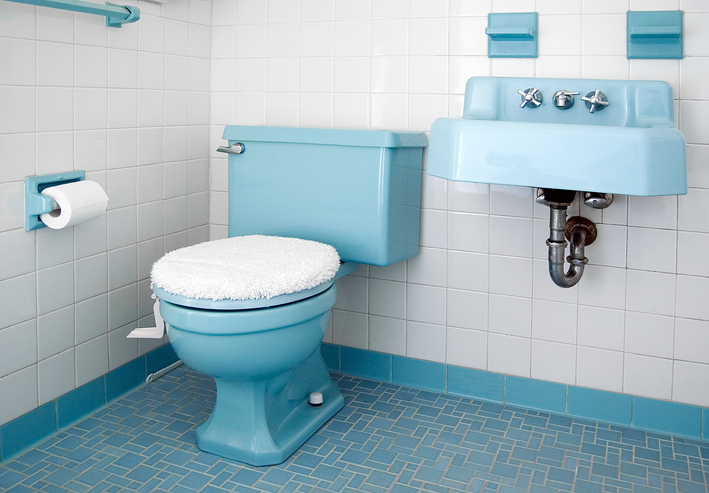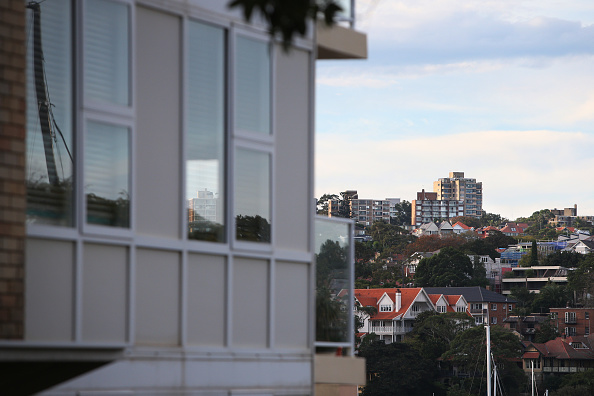Baby Blue Tubs and Lemony Loos. Are Coloured Bathroom Fixtures Chic Again?
The divisive trend has design pros in a lather. Here, they argue both sides.
COLOURED TUBS and sinks are getting another shot. Design experts are revisiting the look, which originated in the 1920s. American waterworks brand Kohler recently revived two heritage colors they originally released in the ’20s and ’30s, and British manufacturers such as the Water Monopoly and the Bold Bathroom Company have found fans on both sides of the Atlantic.
Some designers, however, wincingly recall the avocado-hued tubs and sinks of the 1970s and hold that coloured fixtures are a trend that will date very quickly. For these naysayers, only white bath fixtures will do. Here, they debate the issue.
Yes, coloured fixtures give a bathroom a much-needed shot of style.
Many design pros applauded the news that come summer, Kohler’s bathroom fixtures—including toilets—will be available in two shades from its archive: Spring Green, an icy teal, and Peachblow, a mauvy pink. Fans of the chromatically diverse Rockwell collection from the Water Monopoly, meanwhile, appreciate the fixtures’ vaguely vintage eccentricity.
London interior designer Lizzie Green nestled a Powder blue Rockwell tub, one with a puffy upper rim and spheres for feet, against a wall of variegated green-blue tiles (above). “The playful design creates a center piece in a large bathroom,” she said. (In a similarly bold move, Ms. Green installed a blue art deco pedestal sink from British manufacturer the Bold Bathroom Company in a shower room clad in rose-pink tile.)
Elizabeth Metcalfe, of EM Design in Toronto, made a chalky green Rockwell tub the hero of a primary bath and a foil to some serious luxury. It sits amid walls of Breccia marble—a creamy stone veined in deep purple—and windows hung with pink cashmere drapery. The tub gives an otherwise conservative, grown-up room a “uniquely stylish” edge, she said.
The designers we surveyed agree that the trend’s biggest fans are older millennials who grew up in what Lauren Lothrop Caron terms the “beige 2000s.” The founder of Seattle’s Studio Laloc—a senior millennial herself—urges her contemporaries to be bold. For her own bathroom remodel, she’s eyeing Kohler’s Peachblow fixtures.
Noncommittal types might do best to choose one small colored fixture, says Jake Rodehuth-Harrison, founder of Los Angeles design firm Hubbahubba. Mr. Rodehuth-Harrison loves the “heavy dose of nostalgia” the pieces provide at a time when “the design world and algorithms are always looking forward and saying new, newer, newest.” He popped lilac ball feet onto another Water Monopoly Rockwell tub, this one white, in a Napa Valley, Calif., project. The result perches, most surprisingly, on muted green flooring he chose. If that’s too bold, “we can neutralize these fixtures by surrounding them with tiles in the same color,” he noted.
Another trick: Tiffany Duggan of London’s Studio Duggan suggests working with vintage fixtures that were born white. The designer recently updated an original iron tub with a wash of Farrow & Ball’s Red Earth. “If you change your mind, you can just paint over it.”
No, colored basins and bathtubs are too fatally trendy and impractical besides.
Doubters say hued baths will be a blip on the trend continuum. Unless you’re trying to preserve the aesthetic of a historic home, warned Liana Hawes Young, creative director of Wimberly Interiors in New York City, “colored fixtures will feel dated quickly, if not immediately.” And unlike trendily tinted shower curtains or wall paint that can be changed with little expense, this craze requires a spendy swap out, argued naysayers. Said Kristina Phillips, an interior designer in Ridgewood, N.J., “Clients looking for more long-term, classic design, along with keeping eventual resale in mind, might hesitate.”
Traditionalists say that if you really must, relegate such vivid choices to powder rooms and kids’ baths, spaces you don’t linger in. And well-intentioned salvage-scourers should be wary of mixing eras, said other concerned parties. “Vintage plumbing fixtures can date a space due to their scale,” explained Hattie Collins, founder of Hattie Sparks Interiors, in New Orleans. “Most times, coloured tubs and toilets are much smaller than present-day fixtures.” A safer bet, she suggests, is to focus on rescuing original floor and surround tile.
Powder blue is one thing, many say, but bright or hot-hued renditions of this trend read garish. “Neons and oranges could be a thorn in the room,” said Los Angeles designer Gilda Hariri. Even Ms. Metcalfe, who otherwise champions the trend, warned, “Avoid vibrant, aggressive tones, such as reds and oranges, that evoke a strong emotional response.”
Designers who actually can see a place for coloured fixtures couldn’t help but trivialise the trend as “retro” and “eclectic.” The rest of the room has to quietly suggest luxury, they suggest, to balance kookiness with class. Ms. Collins thinks wallpaper that has layered, expressive colours—the sort often offered by House of Hackney, Gracie or Cole and Son—could help coloured fixtures read higher end, as would lighting of reeded glass and high-quality metal finishes. “Lovely but expensive,” she added. Is the cost of a cheerful toilet really worth it?
The power of association doesn’t work well in the trend’s favor, either. A black bathroom, for instance, installed for a sense of refined moodiness, might evoke one from a 1980s basement nightclub, giving words like sterility and sanitary a new appeal. Austere white bathrooms, a holdover from the “hospital white’” tiled bathrooms of the early 1920s, are far more practical. Dark colours reveal water marks and chalky toothpaste smears. To Kristine Renee, co-founder of Sacramento, Calif., interiors firm Design Alchemy, “Nothing ever seems as clean as white.”
The Wall Street Journal is not compensated by retailers listed in its articles as outlets for products. Listed retailers frequently are not the sole retail outlets.
 Copyright 2020, Dow Jones & Company, Inc. All Rights Reserved Worldwide. LEARN MORE
Copyright 2020, Dow Jones & Company, Inc. All Rights Reserved Worldwide. LEARN MORE
This stylish family home combines a classic palette and finishes with a flexible floorplan
Just 55 minutes from Sydney, make this your creative getaway located in the majestic Hawkesbury region.
As Paris makes its final preparations for the Olympic games, its residents are busy with their own—packing their suitcases, confirming their reservations, and getting out of town.
Worried about the hordes of crowds and overall chaos the Olympics could bring, Parisians are fleeing the city in droves and inundating resort cities around the country. Hotels and holiday rentals in some of France’s most popular vacation destinations—from the French Riviera in the south to the beaches of Normandy in the north—say they are expecting massive crowds this year in advance of the Olympics. The games will run from July 26-Aug. 1.
“It’s already a major holiday season for us, and beyond that, we have the Olympics,” says Stéphane Personeni, general manager of the Lily of the Valley hotel in Saint Tropez. “People began booking early this year.”
Personeni’s hotel typically has no issues filling its rooms each summer—by May of each year, the luxury hotel typically finds itself completely booked out for the months of July and August. But this year, the 53-room hotel began filling up for summer reservations in February.
“We told our regular guests that everything—hotels, apartments, villas—are going to be hard to find this summer,” Personeni says. His neighbours around Saint Tropez say they’re similarly booked up.
As of March, the online marketplace Gens de Confiance (“Trusted People”), saw a 50% increase in reservations from Parisians seeking vacation rentals outside the capital during the Olympics.
Already, August is a popular vacation time for the French. With a minimum of five weeks of vacation mandated by law, many decide to take the entire month off, renting out villas in beachside destinations for longer periods.
But beyond the typical August travel, the Olympics are having a real impact, says Bertille Marchal, a spokesperson for Gens de Confiance.
“We’ve seen nearly three times more reservations for the dates of the Olympics than the following two weeks,” Marchal says. “The increase is definitely linked to the Olympic Games.”

Getty Images
According to the site, the most sought-out vacation destinations are Morbihan and Loire-Atlantique, a seaside region in the northwest; le Var, a coastal area within the southeast of France along the Côte d’Azur; and the island of Corsica in the Mediterranean.
Meanwhile, the Olympics haven’t necessarily been a boon to foreign tourism in the country. Many tourists who might have otherwise come to France are avoiding it this year in favour of other European capitals. In Paris, demand for stays at high-end hotels has collapsed, with bookings down 50% in July compared to last year, according to UMIH Prestige, which represents hotels charging at least €800 ($865) a night for rooms.
Earlier this year, high-end restaurants and concierges said the Olympics might even be an opportunity to score a hard-get-seat at the city’s fine dining.
In the Occitanie region in southwest France, the overall number of reservations this summer hasn’t changed much from last year, says Vincent Gare, president of the regional tourism committee there.
“But looking further at the numbers, we do see an increase in the clientele coming from the Paris region,” Gare told Le Figaro, noting that the increase in reservations has fallen directly on the dates of the Olympic games.
Michel Barré, a retiree living in Paris’s Le Marais neighbourhood, is one of those opting for the beach rather than the opening ceremony. In January, he booked a stay in Normandy for two weeks.
“Even though it’s a major European capital, Paris is still a small city—it’s a massive effort to host all of these events,” Barré says. “The Olympics are going to be a mess.”
More than anything, he just wants some calm after an event-filled summer in Paris, which just before the Olympics experienced the drama of a snap election called by Macron.
“It’s been a hectic summer here,” he says.

AFP via Getty Images
Parisians—Barré included—feel that the city, by over-catering to its tourists, is driving out many residents.
Parts of the Seine—usually one of the most popular summertime hangout spots —have been closed off for weeks as the city installs bleachers and Olympics signage. In certain neighbourhoods, residents will need to scan a QR code with police to access their own apartments. And from the Olympics to Sept. 8, Paris is nearly doubling the price of transit tickets from €2.15 to €4 per ride.
The city’s clear willingness to capitalise on its tourists has motivated some residents to do the same. In March, the number of active Airbnb listings in Paris reached an all-time high as hosts rushed to list their apartments. Listings grew 40% from the same time last year, according to the company.
With their regular clients taking off, Parisian restaurants and merchants are complaining that business is down.
“Are there any Parisians left in Paris?” Alaine Fontaine, president of the restaurant industry association, told the radio station Franceinfo on Sunday. “For the last three weeks, there haven’t been any here.”
Still, for all the talk of those leaving, there are plenty who have decided to stick around.
Jay Swanson, an American expat and YouTuber, can’t imagine leaving during the Olympics—he secured his tickets to see ping pong and volleyball last year. He’s also less concerned about the crowds and road closures than others, having just put together a series of videos explaining how to navigate Paris during the games.
“It’s been 100 years since the Games came to Paris; when else will we get a chance to host the world like this?” Swanson says. “So many Parisians are leaving and tourism is down, so not only will it be quiet but the only people left will be here for a party.”
This stylish family home combines a classic palette and finishes with a flexible floorplan
Just 55 minutes from Sydney, make this your creative getaway located in the majestic Hawkesbury region.






















